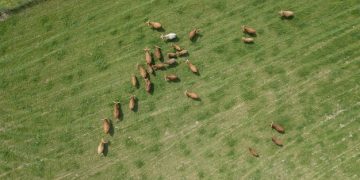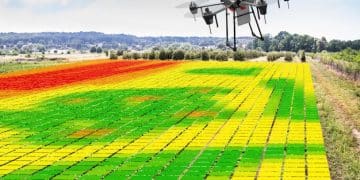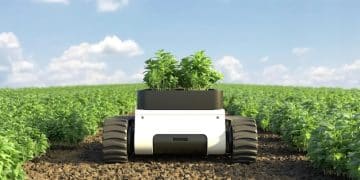Data-Driven Farming: Boost Crop Yields & Cut Waste with Analytics
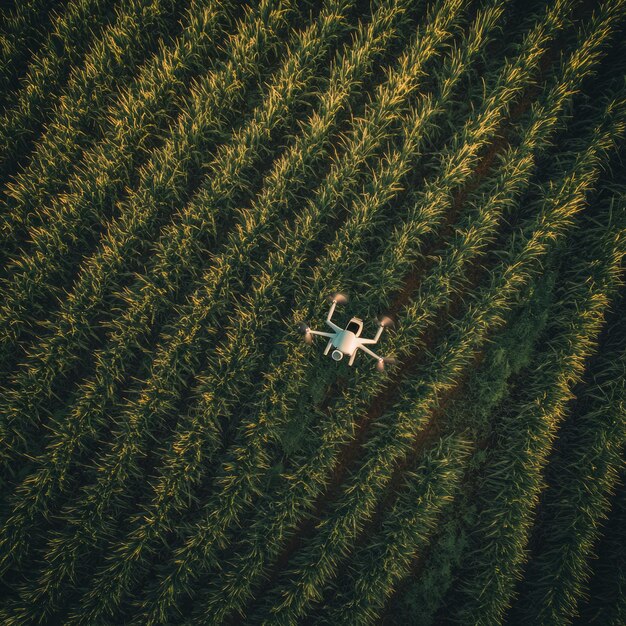
Data-driven farming utilizes analytics to precisely manage resources, optimize crop production, and minimize waste through real-time data insights, leading to more sustainable and efficient agricultural practices.
Discover how data-driven farming, leveraging analytics for improved crop yields and reduced waste, is transforming modern agriculture and offering sustainable solutions for farmers.
Unlocking the Power of Data in Agriculture
Modern agriculture is undergoing a revolution fueled by data. Data-driven farming is no longer a futuristic concept but a present-day reality, enabling farmers to optimize their operations, increase yields, and reduce waste in unprecedented ways.
By harnessing the power of analytics, farmers gain actionable insights into every aspect of their operations, from soil conditions to weather patterns. Let’s explore how data-driven strategies are redefining the landscape of farm technology.

The Core Principles of Data-Driven Agriculture
Data-driven agriculture revolves around collecting and analyzing data to make informed decisions. This approach empowers farmers to move beyond traditional methods and adopt precision farming techniques that are both efficient and sustainable.
The shift involves integrating various technologies to gather data and implementing analytical tools to transform this data into actionable insights.
Data Collection Techniques in Farming
Effective data collection is the foundation of data-driven agriculture. Several technologies and methods are employed to gather comprehensive data:
- Sensors: Installed in fields to monitor soil moisture, temperature, nutrient levels, and other critical parameters.
- Drones: Equipped with cameras and sensors to capture aerial imagery, assess crop health, and identify potential issues.
- Weather Stations: Provide real-time weather forecasts, including temperature, rainfall, humidity, and wind speed.
- GPS Technology: Used to track equipment and map fields for precise application of resources.
These data collection methods provide a holistic view of the farm environment, enabling farmers to make informed decisions.
Data Analysis Tools and Software
The data collected from various sources is then analyzed using specialized tools and software that provide meaningful insights:
- Geographic Information Systems (GIS): Analyze spatial data to create detailed maps of fields, identifying variations in soil composition and crop health.
- Machine Learning Algorithms: Predict crop yields, detect diseases, and optimize irrigation schedules based on historical data and real-time conditions.
- Data Visualization Tools: Present complex data in an accessible format, allowing farmers to quickly identify trends and patterns.
These tools help farmers understand their data and make data-driven decisions.
By systematically collecting and analyzing data, farmers can optimize resource allocation, reduce input costs, and minimize environmental impact.
How Analytics Improves Crop Yields
One of the primary benefits of data-driven farming is the significant improvement in crop yields. By understanding the specific needs of each area within a field, farmers can tailor their inputs to maximize productivity.
Precision agriculture focuses on treating each plant or zone separately, maximizing resource efficiency.
Precision Irrigation Strategies
Efficient irrigation is crucial for crop health and yield. Analytics allows farmers to optimize irrigation schedules based on real-time data on soil moisture levels and weather conditions.
- Variable Rate Irrigation (VRI): Adjusts the amount of water applied to different areas of a field based on their specific needs, preventing over- or under-watering.
- Soil Moisture Sensors: Provide continuous data on soil moisture levels, enabling farmers to water only when and where it is needed.
These strategies lead to significant water savings and improved crop health.
Targeted Fertilizer Application
Applying fertilizer precisely is essential for maximizing crop nutrition and minimizing environmental impact. Data-driven techniques enable farmers to tailor fertilizer application to the specific needs of each area within a field.
By understanding the nutrient levels and crop requirements, farmers can optimize fertilizer usage and promote healthy crop growth.
Early Disease Detection
Spotting and treating diseases at an early stage can significantly impact crop yields. Data-driven farming techniques enable farmers to detect diseases before they spread, minimizing potential losses.
Using analytics can dramatically cut down on problems that are normally attributed to disease, allowing for a higher crop yield in the long run.
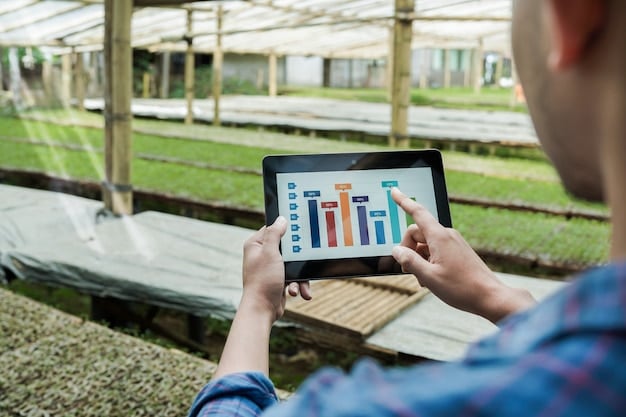
Reducing Waste Through Data Analysis
In addition to improving crop yields, data-driven farming plays a crucial role in reducing waste. By optimizing resource use and minimizing losses, farmers can enhance sustainability and profitability.
Waste reduction is an integral part of the broader goal of sustainable agriculture.
Optimizing Resource Allocation
Data analysis helps farmers allocate resources more efficiently. By understanding real-time conditions and predicting future needs, farmers can avoid overspending on inputs and minimize waste.
Efficient distribution leads to more sustainable and cost-effective farming practices.
Minimizing Crop Losses
Data-driven farming can minimize crop losses due to diseases, pests, and adverse weather conditions. Early detection and proactive management prevent significant damage and ensure higher yields.
Reducing losses contributes to increased profitability and reduced environmental impact.
- Pest Management: Predictive models can forecast pest outbreaks, enabling farmers to take preventive measures and reduce crop damage.
- Weather Monitoring: Real-time weather data helps farmers protect crops from extreme conditions, such as frost, hail, and droughts.
These strategies help farmers safeguard their crops and reduce waste.
Improving Storage and Transportation
Analytics can improve the storage and transportation of crops, reducing post-harvest losses. Monitoring temperature, humidity, and other parameters ensures that crops remain in optimal condition until they reach the market.
Reducing transport and storage waste is a great way to cut down on otherwise good crops being wasted.
Real-World Examples of Data-Driven Farming
Several farms worldwide are successfully implementing data-driven techniques to improve their operations. These real-world examples demonstrate the practical benefits and potential of data-driven farming.
These instances showcase the transformative impact of integrating data and technology into agricultural practices.
Case Study 1: Optimized Irrigation in California
In California, a major almond grower implemented a precision irrigation system based on real-time soil moisture data. The system adjusts water application based on the specific needs of different areas within the orchard, resulting in a significant reduction in water usage and improved nut yields.
This strategy has not only improved the farm’s financial performance but also its environmental sustainability.
Case Study 2: Disease Detection in Europe
A vineyard in Europe uses drone imagery and machine learning algorithms to detect diseases early. By analyzing the aerial images, the system identifies areas affected by fungal infections before they become widespread. This allows the vineyard to apply targeted treatments, minimizing the use of pesticides and reducing crop losses.
Early detection has significantly reduced the need for extensive treatments and preserved crop quality.
Challenges and Considerations
While data-driven farming offers numerous benefits, it also presents several challenges and considerations. Addressing these issues is essential for ensuring the successful implementation of data-driven techniques.
Some problems include data privacy, initial setup cost, lack of technological information, and more. By working through them, farmers will increase their crop yields.
Data Privacy and Security
Collecting and analyzing data raises concerns about privacy and security. Farmers need to ensure that their data is protected from unauthorized access and misuse. Establishing robust data security measures is crucial for maintaining trust and ensuring the integrity of data-driven operations.
- Data Encryption: Protect sensitive data from unauthorized access.
- Access Controls: Limit access to data based on user roles and permissions.
Implementing these measures helps safeguard data and mitigate potential risks.
Initial Investment Costs
Implementing data-driven technologies often requires a significant initial investment. Sensors, drones, software, and other equipment can be costly.
However, the long-term benefits of improved yields, reduced waste, and optimized resource allocation can outweigh the initial costs. Farmers can also explore financing options, such as loans and grants, to help offset the upfront expenses.
Lack of Technical Expertise
Data-driven farming requires a certain level of technical expertise. Farmers may need to invest in training and education to acquire the skills necessary to manage and interpret data effectively.
Collaborating with agricultural consultants and technology providers can provide valuable support and guidance. Continuous learning and adaptation are essential for staying ahead in the rapidly evolving field of data-driven agriculture.
| Key Point | Brief Description |
|---|---|
| 🌱 Increase Crop Yields | Optimize irrigation and fertilizer application for maximal plant growth. |
| 💧 Reduce Resource Waste | Allocate only the necessary resources, cutting excess in water, fertilizer, and pesticides. |
| 🛡 Early Disease Detection | Detect and treat diseases promptly to mitigate damage and maximize health. |
| 📈 Improve Allocation | Efficiently allocate resources and cut down on monetary overspending. |
Frequently Asked Questions
▼
Data-Driven Farming is about using data analytics for informed agricultural decisions, improving crop yields and minimizing waste by optimizing operations across numerous locations.
▼
Data analysis enhances crop yields by optimizing irrigation, fertilizer & proactive disease management, targeting specific needs within fields and increasing yields over time.
▼
Common instruments in data collection include field sensors to monitor soil, drones capturing aerial images, GPS tracking equipment, and weather stations to gather relevant weather data.
▼
Of course, with any data set being used, there are privacy concerns, high initial implementation costs for technologies, and the importance of having the technical expertise to perform.
▼
Data-driven farming minimizes water waste, reduces fertilizer and pesticide usage through more thorough applications, and less crop spoilage while they’re being stored or transported.
Conclusion
Data-driven farming presents an exciting outlook for agriculture, promising greater efficiency, productivity, and sustainability. Farmers who embrace the power of analytics can unlock their farm’s potential and pave the way for a more resilient and profitable future.


